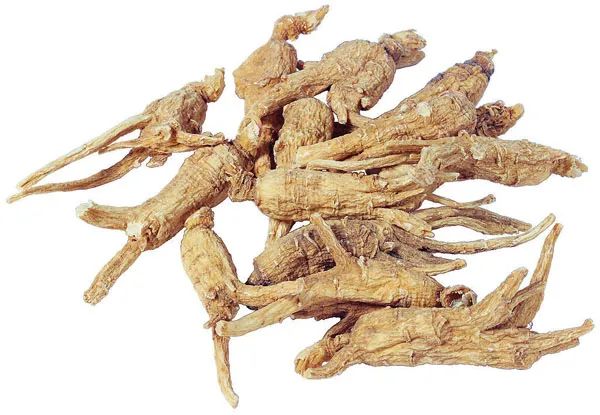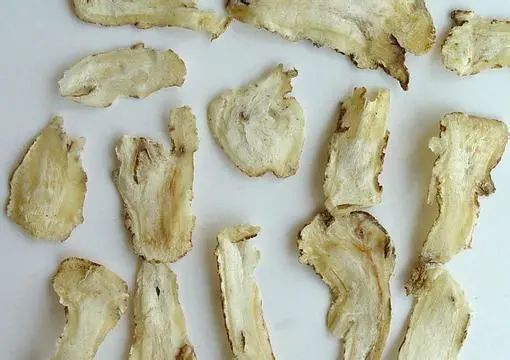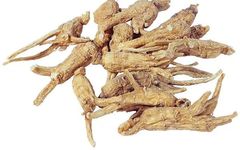
Angelica Sinensis (Dang Gui)
【Herb Name】Angelica Sinensis【Pinyin Name】Dang Gui【Alias】Chinese Angelica, Dong Quai, Female Ginseng.【Family】This herb is the dried root of the plant Angelica Sinensis from the Apiaceae family.【Origin】Primarily produced in Gansu and Yunnan; also found in Sichuan, Shaanxi, Hubei, etc. Gansu’s Min County and Dangchang are known for high yield and quality. Distributed nationwide and exported.【Properties】【Flavor and Nature】Sweet, pungent, warm. Enters the Liver, Heart, and Spleen meridians.【Functions】Nourishes blood, regulates menstruation, invigorates blood circulation, alleviates pain, moistens the intestines, and relieves constipation.【Formulations】A total of 1725 Chinese patent medicines use Angelica Sinensis: Compound Tianma Honey Ringworm Tablets, Compound Ferrous Sulfate Tablets, Compound Ferrous Sulfate Folic Acid Tablets, Hydrochloride Benazepril Tablets, Gui Long Yishen Tongluo Oral Liquid, Zhuanggu Zhuifeng Wine, Du Zhong Bu Tian Su, Zhuanggu Yao Wine, Guogong Wine, Shujin Dingtong Wine, etc.
【Applications】1. Blood deficiency syndromes. This herb is sweet and warm, excellent for nourishing blood, making it a sacred herb for blood replenishment. If both Qi and blood are deficient, it is often combined with Huang Qi (Astragalus) and Ren Shen (Ginseng) to tonify Qi and generate blood, such as in Dang Gui Bu Xue Tang (《兰室秘藏》), Ren Shen Yang Rong Tang (《温疫论》); if blood deficiency leads to pale complexion, palpitations, and insomnia, it is commonly paired with Shu Di Huang (Rehmannia), Bai Shao (White Peony), and Chuan Xiong (Szechuan Lovage) in Si Wu Tang (《和剂局方》).2. Irregular menstruation, amenorrhea, dysmenorrhea due to blood deficiency and stasis. This herb is used to nourish blood, invigorate blood circulation, regulate menstruation, and alleviate pain, often combined with other blood-nourishing and menstruation-regulating herbs, such as Si Wu Tang (《和剂局方》), which is essential for blood nourishment and serves as a foundational formula for gynecological regulation; if accompanied by Qi deficiency, it can be paired with Ren Shen and Huang Qi; if Qi stagnation is present, it can be combined with Xiang Fu (Cyperus) and Yan Hu Suo (Corydalis); if there is blood heat, it can be paired with Huang Qin (Scutellaria) and Huang Lian (Coptis), or Mu Dan Pi (Moutan) and Di Gu Pi (Lycium); if blood stasis leads to amenorrhea, it can be combined with Tao Ren (Peach Kernel) and Hong Hua (Safflower); if blood deficiency and cold stagnation are present, it can be paired with E Jiao (Donkey-hide Gelatin) and Ai Ye (Mugwort).3. Abdominal pain due to deficiency-cold, traumatic injuries, carbuncles, and wind-cold bi pain. This herb is pungent and promotes warmth, serving as a key herb for invigorating blood and Qi. It nourishes blood, invigorates blood circulation, disperses cold, and alleviates pain, often used with Gui Zhi (Cinnamon Twig), Bai Shao, and Sheng Jiang (Fresh Ginger) to treat abdominal pain due to blood deficiency, blood stasis, and cold stagnation, such as in Dang Gui Sheng Jiang Yang Rou Tang (《金匮要略》), Dang Gui Jian Zhong Tang (《千金方》); this herb also alleviates pain and invigorates blood when used with Ru Xiang (Frankincense), Mo Yao (Myrrh), Tao Ren, and Hong Hua for traumatic injuries with blood stasis pain, such as in Fu Yuan Huo Xue Tang (《医学发明》), Huo Luo Xiao Ling Dan (《医学衷中参西录》); combined with Jin Hua (Honeysuckle), Chi Shao (Red Peony), and Tian Hua Fen (Trichosanthes) for detoxifying and reducing swelling, treating initial swelling and pain of carbuncles, such as in Xian Fang Huo Ming Yin (《妇人大全良方》); used with Huang Qi, Ren Shen, and Rou Gui (Cinnamon) for treating non-healing carbuncles, such as in Shi Quan Da Bu Tang (《和剂局方》); it can also be combined with Jin Yin Hua (Honeysuckle), Xuan Shen (Scrophularia), and Gan Cao (Licorice) for treating ulcerations and blood deficiency, such as in Si Miao Yong An Tang (《验方新编》); if there is wind-cold bi pain and numbness of limbs, it can invigorate blood, disperse cold, and alleviate pain, often combined with Qiang Huo (Notopterygium), Fang Feng (Siler), and Huang Qi, such as in Juan Bi Tang (《百一选方》).4. Blood deficiency leading to dry intestines and constipation. This herb nourishes blood to moisten the intestines and relieve constipation. It is often used with Rou Cong Rong (Cistanches), Niu Xi (Achyranthes), and Sheng Ma (Cimicifuga), such as in Ji Chuan Jian (《景岳全书》).【Dosage】Decocted, 5-15g.【Precautions】Contraindicated in cases of dampness and fullness, and diarrhea.【Harvesting and Processing】Harvest after two years of cultivation post-frost; in Yunnan, it may also be harvested before the beginning of winter. After digging up the roots, remove the soil, place them to allow moisture to evaporate slightly until the roots soften, then bundle them according to size and dry them over a low flame to prevent oil from turning black, turning them once to ensure even color. When dried to 70-80%, stop the fire and remove from the drying area. The finished product is yellow-brown externally and powdery white internally. It should not be smoked with coal fire, as this will darken the color, nor should it be directly sun-dried, as it may become hard like dry wood.【Processing Techniques】1. Whole Angelica: Take the original herb, remove impurities, wash clean, slightly moisten, slice thinly, and dry in the sun or at low temperature. Sift out debris.2. Angelica Head: Take clean Angelica, wash, slightly moisten, cut off 4-6 thin slices from the head of the root, and dry in the sun or at low temperature. (This involves taking the head of the Angelica root and slicing it longitudinally.) Sift out debris.3. Angelica Body: Take the original herb, remove impurities, wash clean, moisten thoroughly, remove fibrous roots, and slice the main root thinly, then dry in the sun or at low temperature. Sift out debris.4. Angelica Tail: Take the original herb, remove impurities, wash clean, moisten thoroughly, slice the fibrous root part, and dry in the sun or at low temperature.5. Wine Angelica: Take Angelica slices, mix with a specific amount of yellow wine, slightly moisten, and after the wine is absorbed, place in a special container and heat gently until a deep yellow color is achieved, then cool. For every 100kg of Angelica slices, use 10kg of yellow wine.6. Soil-fried Angelica: Place soil powder in a frying container, heat over medium fire, fry until flexible, then add Angelica slices and fry until the slices are coated with fine soil powder (commonly known as “hanging soil”), then remove. Sift out the soil powder and cool. For every 100kg of Angelica slices, use 30kg of soil powder.7. Charred Angelica: Take Angelica slices, place in a frying container, heat over medium fire until the surface is slightly blackened, then remove and cool.【Storage】Store in a cool, dry place, protect from moisture, pests, and oil spoilage. Smoke products should be placed in a dry container and sealed.【Modern Research】1. Chemical Composition: Angelica contains β-pinene, α-pinene, camphene, and other neutral oil components. It also contains p-methylbenzyl alcohol, 5-methoxy-2,3-dimethylphenol, organic acids, sugars, vitamins, amino acids, etc.2. Pharmacological Effects: The volatile oil of Angelica can counteract the excitatory effects of epinephrine-pituitary posterior fluid or histamine on the uterus. The water or alcohol-soluble non-volatile substances of Angelica have excitatory effects on isolated uteri, enhancing uterine contractions; with large or multiple doses, even tonic contractions may occur, with alcohol-soluble substances being more potent than water-soluble ones. In isolated toad heart perfusion experiments, the decoction containing volatile oil significantly inhibited both the amplitude and frequency of contractions. The extract of Angelica has a significant dilating effect on isolated guinea pig coronary arteries, increasing coronary blood flow. In anesthetized dogs, intravenous administration of Angelica showed no significant change in heart rate, but decreased coronary resistance and total peripheral resistance, significantly increasing coronary blood flow, while myocardial oxygen consumption significantly decreased, with a trend of increased cardiac output and cardiac index. The neutral oil of Angelica also has a significant protective effect against experimental myocardial ischemia. Both Angelica and its sodium ferulate exhibit significant anti-thrombotic effects. Oral administration of Angelica water extract in mice significantly promotes the generation of hemoglobin and red blood cells.【Clinical Applications】1. Treatment of cerebral thrombosis: 30g of Angelica, 30g of He Shou Wu (Fleeceflower Root), 10g of Tao Ren, 10g of Hong Hua, 15g of Chi Shao, 15g of Chuan Xiong, 10g of Pangolin, decocted in water, one dose per day. In a study of 107 cases, after three months of treatment, 48 cases had basic recovery, 40 cases showed significant improvement, 15 cases improved, and 4 cases were ineffective. (《中医杂志》1980;(9):45)2. Treatment of migraine: Angelica injection was administered at the Neiguan (PC6) acupoint, 1ml per point. In the acute phase, once daily; in the remission phase, every other day. In a study of 31 cases, 16 were cured, 8 showed significant effects, and 7 were effective. (《浙江中医学院学报》1991;15(2):47)3. Treatment of upper gastrointestinal bleeding: Dried Angelica powder, 4.5g per dose, three times daily. In a study of 40 cases (excluding esophageal variceal bleeding), 30 showed significant effects, 4 were effective, and 6 were ineffective, with an average of 5 days for stool to turn negative. (《辽宁中医杂志》1982;(6):40)4. Treatment of gastritis and gastric/duodenal ulcers: 15-30g of Angelica, 10g of Fritillaria, 6-15g of Ku Shen (Sophora), boiled in 1500ml of water until reduced to 500ml, one dose per day, divided into three doses before meals. For those with depression fire injuring Yin, use Chuan Bei Mu; for those with liver and stomach Qi stagnation, use Da Bei Mu; for those with acute pain, combine with Bai Shao and Gan Cao; for those with Qi stagnation, add Jiu Xiang Chong and Gan Song. In a study of 155 patients diagnosed with gastritis via barium meal examination, 20 with duodenal ulcers, and 5 with gastric ulcers, 146 were cured, 32 improved, and 2 were ineffective. (《河南中医》1992;(1):17)5. Treatment of habitual constipation: 20g each of Angelica and Lai Fu Zi (Radish Seed). Boil with 6 times the amount of water for 2 hours, filter after sedimentation, and mix with 200g of honey to boil until dissolved. Take 200ml daily, divided into two doses; significant effects can be seen after 3-5 days, and after bowel movements are regular, reduce to 30-50ml daily for a 10-day course. In a study of 117 cases, 110 were effective. (《湖南中医杂志》1987;3(1):11)6. Treatment of enuresis: 60g of Angelica, 30g of Che Qian Cao (Plantago), 10g of roasted Ma Huang (Ephedra), decocted to 200ml; for those under 14 years, 100ml; for those over 14 years, 200ml, taken one hour before sleep for a 7-day course. In a study of 100 cases, after 4-14 days of treatment, 72 were cured, 13 showed significant effects, 10 were effective, and 5 were ineffective. (《江苏中医》1990;11(8):15)7. Treatment of acute intestinal obstruction: 50g of Angelica, 15g each of Mu Xiang (Aucklandia) and Lai Fu Zi; for Qi stagnation type; add 10g of Chi Shao and 15g of Da Huang (Rhubarb) for stasis type; 50g of Angelica, 15g each of Dang Shen (Codonopsis), Da Huang, 1.5g of Gan Jiang (Dried Ginger), and 10g of Gan Cao for deficiency-cold type. Decocted in water, one dose per day, supplemented with manual massage. In a study of 84 cases, the cure rate was 75%, with 63 cases of adhesive intestinal obstruction, 55 of which were cured. (《白求恩医科大学学报》982;(2):81)8. Treatment of herpes zoster: Angelica powder, 0.5-1g per dose, taken every 4-6 hours. In a study of 54 children with herpes zoster, 22 had pain relief after one day, 32 after two days. Generally, by the third day of medication, some vesicles had dried up, and no new rashes occurred; by the fourth day, scabs formed, with complete recovery in 6-7 days. (《中华医学杂志》1961;(5):317)9. Treatment of dysmenorrhea: Angelica, Bai Shao, Chuan Xiong, Fu Ling, Bai Zhu, and Ze Xie in a ratio of 1:5.6:2.7:1.3:1.3:2.7, ground into fine powder, encapsulated with 0.4g per capsule. For moderate pain, take 6 capsules each time; for severe pain, take 8 capsules, three times daily. For excess-type dysmenorrhea (Qi stagnation and blood stasis, cold-damp obstruction type) and liver-spleen disharmony type, take the medication two days before menstruation; for deficiency-type dysmenorrhea (Qi and blood deficiency, liver and kidney deficiency type), start taking on the first day after menstruation ends. In a study of 20 cases, for a 7-day course over three menstrual cycles, blood viscosity indicators measured before treatment were higher than normal values, while sedimentation K values were lower than normal. After treatment through the fourth menstrual cycle, whole blood high shear, low shear viscosity (ratio), and plasma viscosity (ratio) in the Angelica group were lower than the control group, and the plasma PGE2a content and sedimentation K values returned to normal. This indicates that dysmenorrhea patients have abnormal blood rheology, with elevated plasma and menstrual blood PGE2a content, which can be significantly improved with Dang Gui Shao Yao San treatment. (《中成药》1990;12(10):24)10. Treatment of alopecia areata: 500g each of Angelica and Bai Zi Ren (Arborvitae Seed), ground into fine powder, mixed with honey to form pills the size of beans, taken three times daily after meals. In a study of over 40 cases, the results were satisfactory. (《陕西中医》1987;(9):419)【Tea Therapy Recipes】1. Angelica Lamb Soup[Ingredients] 500g lamb, 15g Angelica, 15g fresh ginger, 6g salt, 15g cooking wine, appropriate amount of monosodium glutamate.[Method] Wash Angelica and ginger, slice them. Remove the membranes from the lamb, blanch in boiling water to remove blood. Cut into strips of 5cm long and 2cm wide. In a clean pot (preferably a clay pot), add an appropriate amount of water, then add the lamb strips, Angelica, and ginger. Bring to a boil over high heat, skim off the foam, add seasonings, and simmer on low heat for about 1.5 hours until the lamb is tender.[Health Tip] Suitable for abdominal cold pain due to blood deficiency, postpartum cold abdominal pain in women, or cold-type dysmenorrhea.2. Angelica and Earth Lamb Stew[Ingredients] 500g lamb, 15g Angelica, 15g Sheng Di (Rehmannia), 15g fresh ginger, 25g soy sauce, 10g scallions, 3g ginger, 3g garlic, 600g vegetable oil (50g oyster sauce), appropriate amounts of salt, monosodium glutamate, and cooking wine.[Method] Slice Angelica, Sheng Di, and fresh ginger, selecting 5g of each for aesthetic purposes, adding directly, while the remaining parts are boiled to extract a concentrated juice of 25g. Cut the lamb into rectangular pieces of 4.5cm long and 2cm wide. In a pot over high heat, add vegetable oil, and when it smokes, add the lamb pieces and fry until golden brown, then remove. Place a clay pot over low heat, add the fried lamb, cover with water, and add seasonings and the concentrated juice of Angelica, simmer until the meat is tender (about 2 hours). In the last 30 minutes, add the three sliced herbs to the pot. After cooking, remove the herbs and arrange them neatly around the meat in the serving dish as decoration.[Effects] Tonifies Qi and nourishes blood, warms the middle and replenishes deficiency.[Uses] Suitable for patients recovering from illness, postpartum, anemia, and kidney deficiency.3. Angelica and Pig Trotter Soup[Ingredients] 2 pig trotters, 30g Angelica.[Method] Boil the pig trotters and Angelica together to make soup.[Effects] Nourishes blood and promotes lactation.[Uses] Suitable for postpartum blood deficiency and breast swelling leading to insufficient milk production.4. Angelica Liver[Ingredients] 10g Angelica, 60g lamb liver (or pig liver).[Method] Cook Angelica with the liver, slice the liver after it is cooked.[Health Tip] Nourishes blood, benefits the liver, and brightens the eyes. Suitable for those with dizziness due to liver blood deficiency, blurred vision, night blindness, or eye pain without redness.5. Black Fungus and Angelica Soup[Ingredients] 10g black fungus, 4g each of Angelica, Bai Shao, Huang Qi, Gan Cao, Chen Pi, and Longan meat.[Method] Wash all ingredients and steam until cooked.[Health Tip] Nourishes blood and promotes circulation, resolves symptoms and eliminates masses. Suitable for cervical cancer, vaginal cancer, etc.6. Er Ren Tong You Soup[Ingredients] 9 peach kernels, 6 Yuli Ren (Cherry Seed), 5g Angelica tail, 1g fennel, 1.5g saffron.[Method] Boil the five ingredients together, strain, and drink at any time.[Health Tip] Moistens the intestines and relieves constipation, promotes Qi circulation and reduces bloating. Suitable for abdominal distension and constipation due to blood stasis.
Angelica Images
 Angelica
Angelica
 Original Plant of Angelica
Original Plant of Angelica
 Angelica Slices
Angelica Slices

Copyright belongs to the original author. If there is any infringement, please contact us promptly, and we will delete it immediately. Thank you.


